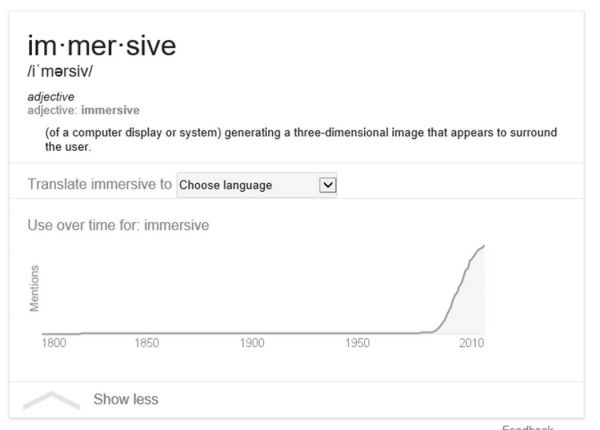Following the development of virtual reality and to a certain degree also augmented reality technology, we keep hearing about how immersive these new experiences are. As a matter of fact, I have also used this term more than once and of course assumed that everyone understands very clearly what I mean by that. In general, I still believe that immersive is a term that most readers involved in the display industry understand.

So you can understand my surprise that the Merriam Webster dictionary does not list ‘immersive’ as a word at all. Of course, immersion is a word that describes someone or something being completely in a liquid or being completely involved in some activity. Then there is the easy way of putting the word into a Google search bar and read the results for the next few weeks. Google returns 530,000 results on the search term ‘definition immersive’. They actually show how the use of the word immersive has been increasing since the seventies.

Other on-line dictionaries have the word immersive in their database and to my surprise focus on the term in conjunction with electronic displays and media.
• Cambridge On-line Dictionary:
“seeming to surround the audience, player, etc. so that they feel completely involved in something”
• Oxford On-line Dictionary:
“Of a computer display or system, generating a three-dimensional image that appears to surround the user”
• Dictionary.com:
“noting or pertaining to digital technology or images that deeply involve one’s senses and may create an altered mental state: immersive media”
As it seems, immersive is actually a term most likely used by the display industry to describe how well a certain technology or installation is capable of fooling the consumer into believing that something is real, that is actually not real. For example, I would have used this term to describe how an IMAX movie theater is different from a screen with the typical theatrical wide screen aspect ratio. In my own words, it describes how a display can fool me into believing something that is non-existent.
So, if immersive is only a loosely defined word used mainly by the display industry, how can we expect the consumer to understand what this means? And to go one step further, do we industry insiders all really understand what this means? Thinking about this conundrum of a word that is not clearly defined but is used to describe the consumer benefit for the new VR technology, I wonder if this is really a good approach? From a marketing perspective, this can’t get any better. Of course I am more immersive than anyone else, if I can define the term any way I want it. On the other hand it makes it pretty difficult for the consumer to understand what he is buying in the first place. And of course there is the risk that the consumer has something very different in mind when he buys an ‘immersive’ headset for a substantial amount of money.
When we think of the nausea issues that some users experience with VR headsets, we may ask ourselves if this immersive thing is actually a good thing at all? These VR-related issues are a big topic for the science world at the moment, as they try figuring out how to trick the brain into seeing and believing VR content without getting sick.
I think there is a good chance we are trying to do too much without knowing what we can actually achieve at this point in time. There are still development requirements for hardware platforms and for content creation at a time when we do not even know how a user will react to VR. There will be a lot of good and not so good things happening in the VR world before it will become a major driver in the CE industry. For now it rules the news and investments circles and it will rule the sales as well, as soon as we figure out how to make ‘immersive’ a good thing for the user. – NH

